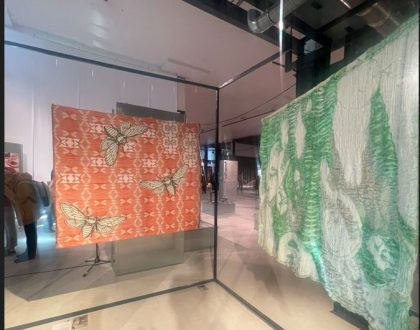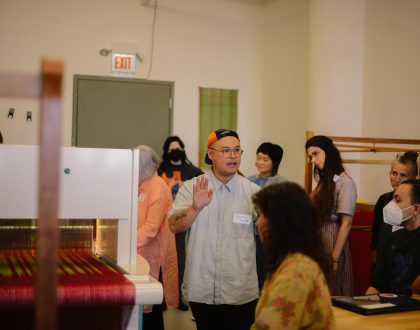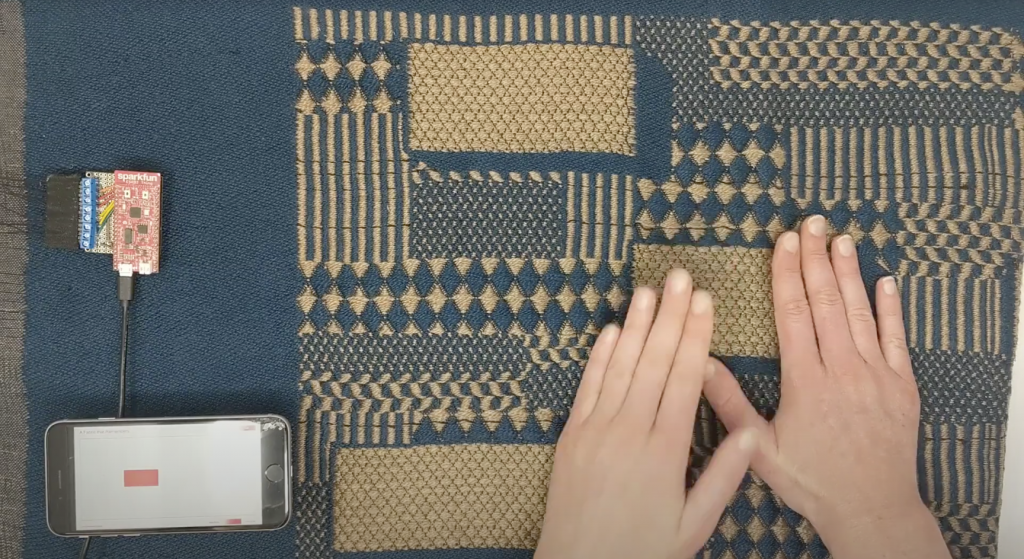Makers Space Profile #1: Unstable Design Lab

by admin
TEXTILES are everywhere. You can see, touch and feel them, you can also make them do things. But each new material must first be explored and tested in a controlled environment, for its look and feel, its properties and performance. The journey from visualizing to materializing, thinking to rethinking, discovery to rediscovery, is crucial and ongoing until the result is achieved.
One such setting where the team of technologists, artists, designers, and researchers are making textiles that “do things for us” is the Unstable Design Lab in the US. The Lab’s Director Laura Devendorf tells us all about the Lab, the People and some seriously-interesting Projects that they’ve been working on…
The Thought…
The Unstable Design Lab is a space that is looking to serve as a bridge between engineers and weavers. We do this because we are inspired by the various mechanical and material properties woven structures can afford and because we think a deeper integration of textile-craft in technological development can lead to more sustainable and humane relationships with technology. We envision futures in which our electronics are hand-crafted and our interactions with technology help us reflect and form compassionate relationships with both humans, animals and the earth more broadly. This is a broad and ambitious vision, and we are working towards it slowly.
The Place…
The lab is a collection of people as well as a physical space. Our physical lab is located in the ATLAS Institute at the University of Colorado, Boulder (USA) . It is part of a constellation of labs and studios that are inventing new bio-materials, building avant-garde games, or studying interactions with drones (to name a few). When you enter the lab, you will see a large, shared table (sometimes with snacks, sometimes without), shelves full of specialty yarns made of materials like copper, silver, and carbon nanotubes, looms, knitting needles, drop spindles, and most importantly a 3-Wide TC2. Lately, we have been using our TC2 to design and produce textiles with embedded circuitry. By adding in weft pics of metallic yarns, and interconnecting them during the weaving process, we have been exploring how weaving can help us make circuits that are flexible, large, stretchy, and can respond to our daily interactions. Lately, we’ve been really curious about the various ways that textile structures can remember or record the interactions that take place upon them.
A Fabric that Remembers (seen below), woven on the TC2, uses 2-pic structures to create regions that can sense and respond to a human press. The fabric is currently on display at Accenture Labs in San Francisco and uses both the fabric and tablet to visualize touch in realtime. The constraint that guided the work was to get as much of the circuitry as possible embedded into the fabric. Thus, for the e-textiles nerds out there, you might be happy to know that all of the wiring for the resistive sensing and voltage dividing is embedded into the fabric by way of using different resistance yarns. We have included all of the swatches I made in preparation for the final design for reference.
The People…
The people working in the Lab include myself (Laura Devendorf, the director) and students and faculty from the various academic programs at the University of Colorado. These students are working towards graduate and undergraduate degrees in programs such as Intermedia Art Writing and Performance, Information Science, Creative Technology and Design, Media Studies, and Computer Science. We work together to explore various dimensions of weaving and technology. For instance, Shanel Wu is researching woven structures that can easily disassemble; Mikhaila Friske is studying how we can craft data into our textile objects to retell past experiences; Sasha de Koninck is creating provocations for garments of the future; Emma Goodwill is working on building a machine learning model that can learn the styles of different weaving traditions; and Steven Frost continues to make extraordinary tapestries and artifacts that speak to memes and queer histories.
The Projects…
Our work is held together (and funded) by a few cornerstone projects that form the foundation of our research. The first is AdaCAD , an open-source tool for weaving with a focus on integrating metallic yarns to create electrical components. Open-source means that we do not sell the software and anyone is invited to contribute to its development through platforms like GitHub.
AdaCAD is a project of the Unstable Design Lab that aims to support the requirements of what we call “experimental weaving” but that has basic functions to support all weavers. Experimental weaving is a mentality more than a set of materials or practices. We see an experimental weaver as someone who considers structure, material, cloth, and artifact in tandem. At times, this leads us to investigate metallic yarns for the purposes of handweaving sensors and interactive systems. At other times, it might mean adding bio-components to different sections of the weave to support different material changes over time.
Another project (woven on the TC2) is Wear, a fabric that lived on my body during the COVID 19 lockdown. It is sensitive to the forces exerted upon my body by children, objects, and electric fields. It is a Design Memoir in the form of a handmade woven garment with integrated circuitry that measures the forces on my body. Wear plays back records captured during 12 hours of wearing by heating different regions of the fabric in response to where force was measured most.
Video of Weaving: LINK | Concept Video for Project: LINK
The next project includes a course and textbook where we share the resources we teach to students interested in the intersection of textiles and engineering. The final project takes the form of artist residency, called the Experimental Weaving Residency, where we invite weavers to join our lab and collaborate on an engineering challenge. Our first resident was Sandra Wirtanen and together we developed methods for weaving electrodes that could measure muscle activity on the forehead. Having access to the TC2 continues to be a very attractive part of the residency and allows us to create incredibly precise structures to house electronics.
Read about some of the other Projects at the Unstable Lab: HERE
Tryst with Weaving…
I came to weaving after being frustrated with the limitations of 3D printing. My PhD thesis explored different ways that we could use computers to design objects, but I was so frustrated by the lack of participation I could have when it came to building those objects I designed on the computer that I ended up developing a system that let me perform the instructions that would typically have been given to a 3D printer . Through a series of serendipitous events involving a research collaboration with Google’s Project Jacquard team, I came to see weaving as a mode of making that had everything I wanted in 3D printing. I felt that weaving, and textile-arts more broadly, had been overlooked in discussions of computer-aided design and manufacturing, could use diverse material sets, could create incredibly complex shapes and forms, was broadly accessible, and the design process is inherently computational and algorithmic. So, when I began at the University, and began to set up my lab, I set out learning to weave on a 8-Schacht Baby Wolf. I was hooked and began to fund-raise to purchase a TC2 with a collaborator in the Aerospace Engineering department. Since then, I, and others in the lab, have been weaving and designing our own software to interface with the loom. I have been so welcomed and warmed by the weaving community and I feel both honored and inspired by the talent and curiosity of the weavers that I meet.
Recommended Posts

Woven artworks by Amanda Curreri…
March 12, 2025

Digital Weaving Norway’s visit to the Netherlands
October 28, 2024

Weaving Workshop Weekend 2024 at LMRM Chicago
October 15, 2024




